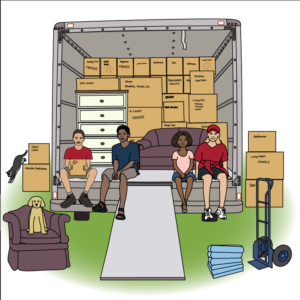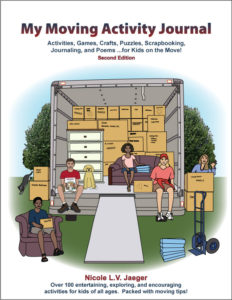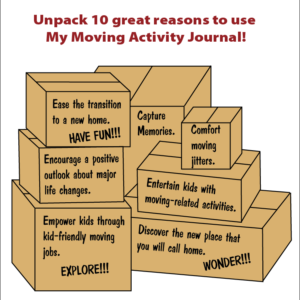Relocating a family is a monumental task.
Even the most organized of parents will likely feel the stress and pressure of staying on top of every-day life while moving. As a parent, I have experienced the reality that, during times of increased stress and transition, my children need me even more than usual, yet I have less time and energy available.
Undoubtedly, moving is a huge distraction, and kids can get a little lost in the shuffle. My Moving Activity Journal can help!
Moving is also a unique opportunity for children to experience new and incredibly valuable life skills.
 According to the American Academy of Child and Adolescent Psychiatry,
According to the American Academy of Child and Adolescent Psychiatry,
“With the proper attention from parents , moving can be a positive growth experience for children, leading to increased self-confidence and improved interpersonal skills.”
For example, when a family in transition finds ways to make each person a part of the process, skills such as team work, cooperation, and responsibility are learned. When change feels scary, a successful attitude can be fostered by focusing on new opportunities. A child that is anxious can learn healthy ways of processing mixed emotions, such as scrapbooking, journaling, and organizing information for staying in touch. And most importantly, during times of stress, keeping a big-picture perspective, and remembering to have fun, are invaluable.
So how does a parent engaged in the marathon of moving simultaneously take advantage of the many opportunities for growth while having fun?
1. Find ways to involve each child in the move, with simple and creative tasks that give a sense of control.
For example, kids can make cards to notify family and friends of their change of address, can decorate a book for recording contact information needed to stay in touch, and can research new parks and libraries to visit after moving. When packing, kids can label boxes, scrunch newspaper, and tape boxes. Making young movers an important part of the process will help them feel more important and secure at a very busy time.
2. Use activities to entertain and engage young movers and to stimulate conversation.
For example, drawing pictures related to the move, and then asking questions about the picture, will encourage conversation. Ask questions and make lists, such as a list of places to visit one last time before moving, paired with a list of similar new places to explore after moving. Encourage kids to make a scrapbook of friends, activities, and favorite places, with a matching scrapbook of clippings and computer printouts of new activities and places awaiting them near their new address. Help kids collect the contact information for every friend that they want to stay connected with. These activities and conversations will reduce moving anxiety.
3. Get excited about the future!
Provide children with materials about the place where you are moving, such as maps, Chamber of Commerce brochures, and mailings sent by organizations offering interesting activities and hobbies. Encourage the older child to research and find these materials on his or her own. Collecting information will turn the unknown into something to look forward to, easing the grief of leaving friends and familiar places behind. Just imagine how exciting driving into your new town will be if your child has already picked a new restaurant to try, or a new park to visit! And just imagine how empowered your child will be if he or she remembers helpful information after the move, such as where to get an oil change, or find pet supplies, or go to the movies.
 My Moving Activity Journal: Activities, Games, Crafts, Puzzles, Scrapbooking, Journaling, and Poems …for Kids on the Move! 2nd Edition, By Nicole L. V. Jaeger
My Moving Activity Journal: Activities, Games, Crafts, Puzzles, Scrapbooking, Journaling, and Poems …for Kids on the Move! 2nd Edition, By Nicole L. V. Jaeger

